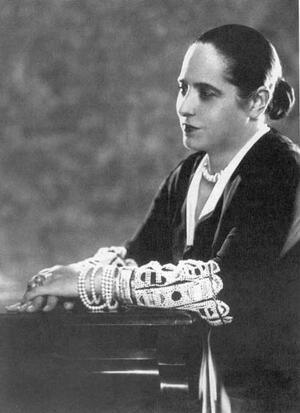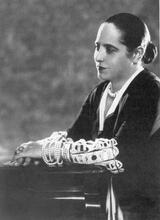Helena Rubinstein
When Helena Rubinstein died at the age of ninety-four, she left behind an international cosmetics business worth millions, and the foundation she established to fund the arts.
Institution: The Jacob Rader Marcus Center of the American Jewish Archives, Cincinnati, OH, www.americanjewisharchives.org and Studio Lipnitzki
Selling face cream to Depression–era housewives and teaching makeup tricks to film vamp Theda Bara, Helena Rubinstein built a global beauty empire. Rubinstein worked as her father’s bookkeeper and studied medicine before immigrating from Poland to Australia in 1902. Local women envied her fair complexion and asked for samples of her face cream, made by a family friend in Krakow. Rubinstein opened a salon in Melbourne and began selling the cream. She studied dermatology and nutrition in Europe and expanded her business to London and Paris before moving to New York in 1915. In the 1920s she began working with Hollywood movie stars while opening salons across the country. Her autobiography, My Life for Beauty, was published posthumously in 1966.
My Life for Beauty, Helena Rubinstein’s autobiography, was published in 1966, a year after her death. In the introduction, her son Roy Titus called his mother’s life and work “so inseparable that a book dealing with one aspect without the other would seem incomplete.” Thus, the first half recounts “My Life,” and the second half, “For Beauty,” includes advice for achieving beautiful skin, hair, nails, and so on. The title is poignant and very appropriate. In addition to her son’s assessment that Rubinstein’s life and work were “inseparable,” the title also lends credence to the theory that she gave her life for beauty. Late in life, she expressed numerous doubts about the wisdom of her absorption in her career in beauty, blaming this involvement for painful costs in her personal life.
Early Life and Family
Helena Rubinstein was born to Jewish parents in Crakow, Poland, on December 25, 1870. Her father, Horace, a not very successful wholesale food broker, was very strict. The beautiful Mama Rubinstein, Augusta (Silberfield) Rubinstein, had a tremendous impact on Helena and her seven sisters (Pauline, Rosa, Regina, Stella, Ceska, Manka, and Erna). Their mother insisted her daughters would gain power and influence through beauty and love. In fact, Helena Rubinstein’s beauty industry began with jars of Modjeska cream, named after her mother’s friend, actor Helena Modjeska. The actor had introduced Mama to the chemist who created the cream, Dr. Jacob Lykusky, a Hungarian chemist living in Crakow. He made the cream from a formula of herbs, essence of almonds, and extract from the bark of the Carpathian fir tree.
As the oldest daughter, Helena was often put in charge of her siblings. As she recounted the story, since her father had no sons (two boys had died as babies), and since she was good with figures, she helped her father with bookkeeping. She attended her first business meeting at age fifteen, substituting for her ill father. Her mother advised her, “If you want to be really clever, listen well and talk little.”
Moving to Australia, Early Career
Her father decided that Helena should study medical science. While she enjoyed the laboratory work, the sights and odors of the hospital sickened her. When she became very thin and unhappy, her father agreed that she could end her medical studies, but insisted that she marry. He picked out a thirty-five-year-old wealthy widower for his eighteen-year-old daughter. She refused to marry him and brought home her own choice, Stanislaw, a non-Jewish University of Cracow medical student. Papa refused. Helena wrote to her Uncle Louis, her mother’s brother, asking if she could stay with him and his family in Australia. Helena Rubinstein left Poland for Australia with twelve pots of her mother’s beauty cream.
The Australian women, who suffered from sun-damaged skin, were awed by Helena Rubinstein’s beautiful skin. Soon Rubinstein had given away almost all of her cream. Her mother kept providing more until Helena decided to open a shop to sell the cream. She got financial backing from Helen MacDonald, a woman whose complexion improved using Helena’s cream. MacDonald loaned her £250, about $1,500, which Rubinstein used to buy a large quantity of the cream and to rent and furnish a shop in Melbourne. After doing the painting and making the curtains and the sign herself, she opened Helena Rubinstein, Beauty Salon. She began experimenting with creams for different kinds of skin in her kitchen. Woman’s page editor Eugenia Stone came from Sydney, some five hundred miles away, to interview Rubinstein. The country-wide publicity resulted in a deluge of orders. She made enough money to bring over Dr. Lykusky to develop related products.
In her autobiography, she says she turned the £250 debt into a £12,000 credit by working eighteen-hour days for two years. Other sources indicate that it took her about eight years, from 1890 to 1898. In Australia, she started the practice of putting one of her sisters or another relative in charge of various parts of her business. She sent first for Ceska, the third youngest sister. She also began her hands-on training by spending a year in Europe, studying with experts to learn about skin treatments, facial surgery, and good dietary practices. For example, she studied dermatology in Paris with Dr. Berthelot.
She put her personal life on hold while she developed her career in business. Meeting and falling in love with American newspaperman Edward William Titus rattled her, as she had never imagined falling in love. When he asked her to marry him, she acknowledged her love, but said she first wanted to establish a salon in London, England. She opened a salon on Grafton Street in Lord Salisbury’s previous home. She continued training in beauty and skin care in Europe and recruited Dr. Emmie List from Vienna to join her London staff. Edward came to London and proposed again. This time she accepted. She was thirty-eight when they married in a private civil ceremony in 1908. Titus continued to write and also advised her in the business, even creating clever advertising for her salon.
Moving to the States
Her first pregnancy forced her to focus on her personal life rather than her business. She created what she called a “real home ... with garden.” With the birth of Roy in 1909 and Horace in 1912, she focused her attention on the children. When Horace was about two, Rubinstein convinced Titus to move to Paris, where she purchased a salon from Madame Chambaron. This salon specialized in herbal preparations. Rubinstein found Paris women more receptive to her innovations in makeup.
In 1915, a year into World War I, Titus finally convinced her to move to the safety of the United States—to New York City. They moved first to West End Avenue on Manhattan’s Upper West Side, and then one block west to Riverside Drive. Thus began her career in America, where her advertisements promised scientific benefits. She opened her New York salon, the Maison de Beauté Valaze, at 8 East 49th Street. Starting in 1916, she expanded her operations, opening salons in San Francisco and Philadelphia. The next year she opened salons in Boston, Los Angeles, Washington, D.C., Chicago, and Toronto. In the twenties, Helena Rubinstein went to Hollywood and taught movie stars Theda Bara and Pola Negri how to use mascara, which emphasized their eyes and created their images as “vamps.” Rubinstein continued her makeup line and also began to train salespeople to sell her products at selected stores. In 1928, she moved her New York salon to the east side at 57th Street.
She wrote of her intensive involvement in her business. Her children went to boarding school. Her husband complained, but she didn’t listen at first. Finally, he told her he was in love with a younger woman. She sold her business to Lehman Brothers in order to win Edward back by showing him how important their marriage was, but it was too late. Meanwhile, the new owners had no luck with the business. Earlier, Rubinstein had developed friendships with store owners during her frequent instructional tours, and these store owners kept in touch with her to report their dismay with Lehman Brothers. Secretly, Helena Rubinstein began to buy stock on the open market. She also wrote to other stockholders, urging them to complain about how the new owners were running the business. Finally, the stock market crash enabled her to buy back her business at a fraction of what Lehman Brothers had paid for it.
Personal Life and Business During The War
Her personal life did not go as well. Both of her ailing parents died before she had the chance to see them again. She suffered terribly. A physician friend insisted that she recover from her grief by traveling to Switzerland, where she could recoup and study diet treatment with Dr. Bircher-Benner. She came back to the United States ten pounds lighter and full of energy, with the idea of bringing this treatment to her salons. “A Day of Beauty” at the Helena Rubinstein salons became popular all over the world.
In 1935, at a party at the home of Comtesse de Polignac, daughter of Jeanne Lanvin, whose haute couture studio was located near her salon, Helena Rubinstein met a Georgian named Prince Artchil Gourielli-Tchkonia. They married three years later, in 1938. They lived in New York City during the winter and in Europe in spring and summer. They were lucky to get out of their Paris apartment in 1939, following the outbreak of World War II.
During the war, some critics suggested that her business products were unnecessary during such hard times, but Rubinstein argued to the contrary. She insisted that during times of trouble and depression, women needed the added lift of makeup. She said that President Franklin Roosevelt agreed, once telling her, “Your war effort ... is to help keep up the morale of our women. And you are doing it splendidly.”
In the late 1940s, Rubinstein opened the House of Gourielli for men, complete with ticker tape from Wall Street, but this venture of selling colognes and facials for men was ahead of its time, although she anticipated the lucrative market of men’s products in the 1990s.
She was profoundly affected by the death of her second husband in 1956, but was able to rebound from this grief to continue her active business life. In addition to using her products, Helena Rubinstein urged women not to smoke, to drink lightly, if at all, and to pay particular attention to physical exercise, proper diet, and inner peace.
Helena Rubinstein died of natural causes on April 1, 1965, at age ninety-four. She was said to have a cosmetics business worth somewhere between $17.5 million and $60 million, with international holdings, including laboratories, factories, and salons in fourteen countries. Helena Rubinstein established the Helena Rubinstein Foundation to provide money for the arts and to charitable institutions. While she did not support Jewish causes in particular, she did donate five hundred thousand dollars to create the Helena Rubinstein Pavilion at the Tel Aviv Museum. Her entire collection of miniature rooms is on display there.
AJYB 67:541.
Allen, Margaret. Selling Dreams: Inside the Beauty Business (1981).
BEOAJ.
DAB 7.
EJ; Fabe, Maxene. Beauty Millionaire: The Life of Helena Rubinstein (1972).
O’Higgins, Patrick. Madame: An Intimate Biography of Helena Rubinstein (1971).
Obituary. NYTimes, April 2, 1965, 1:2.
NAW modern.
Rubinstein, Helena. My Life for Beauty (1966).
Slater, Elinor, and Robert Slater. “Helena Rubinstein.” In Great Jewish Women (1994).
WWIAJ (1938).
WWWIA 4.





